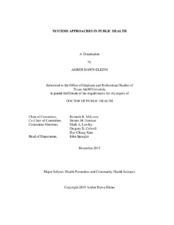| dc.contributor.advisor | McLeroy, Kenneth R | |
| dc.contributor.advisor | Gorman, Dennis M | |
| dc.creator | Elkins, Amber D | |
| dc.date.accessioned | 2016-04-06T16:49:03Z | |
| dc.date.available | 2017-12-01T06:36:21Z | |
| dc.date.created | 2015-12 | |
| dc.date.issued | 2016-01-12 | |
| dc.date.submitted | December 2015 | |
| dc.identifier.uri | https://hdl.handle.net/1969.1/156292 | |
| dc.description.abstract | Recognition of the complexity of many public health problems has led to the search for analytic methods capable of capturing more fully than traditional study designs and statistical tests the underlying dynamic processes at work. Similarly, those with an interest in public health interventions have begun to see the limitations of standard methods in understanding the consequences of programs and policies designed to influence population-level health.
While there are a number of system science methods with potential to further public health research, there are three methods most often applied: agent-based modeling, social network analysis, and system dynamics modeling. The first discussion reviews both theoretical and practical applications of these three methods in the literature, as each has strengths and weaknesses and is better suited to studying some aspects of complex dynamic phenomena than others. Such a discussion provides practical guidance for those who wish to use these system methods in their own research. Following this, there is a discussion of different perspectives on how these methods relate to traditional behavioral research methods, and how these perspectives affect understanding of and explanation of public health problems.
Beginning with a detailed analysis of the three systems methods used in public health and following with a discussion of how different perspectives affect understanding of public health problems sets the stage for the development of a systems model of a complex public health problem. The final section applies these lessons by developing and testing a system dynamics model of type 2 diabetes in the area known as Health Service Region 11. The model framed the problem of diabetes in this region using assumptions implicit within selecting a system dynamics model. The focus was on the effectiveness of physical activity interventions to guide decision-makers in future resource allocation and public health professionals to use appropriate methodologies for complex health problems that traditional linear approaches are unable to capture and thus unable to suggest informed routes for change. The model evaluated different “what if” scenarios of prevention and intervention strategies for reducing prevalence of (and ultimately incidence of) type 2 diabetes. | en |
| dc.format.mimetype | application/pdf | |
| dc.language.iso | en | |
| dc.subject | complex systems | en |
| dc.subject | systems thinking | en |
| dc.subject | public health | en |
| dc.title | Systems Approaches in Public Health | en |
| dc.type | Thesis | en |
| thesis.degree.department | Health Promotion and Community Health Sciences | en |
| thesis.degree.discipline | Health Promotion and Community Health Sciences | en |
| thesis.degree.grantor | Texas A & M University | en |
| thesis.degree.name | Doctor of Public Health | en |
| thesis.degree.level | Doctoral | en |
| dc.contributor.committeeMember | Lawley, Mark A | |
| dc.contributor.committeeMember | Colwell, Gregory B | |
| dc.contributor.committeeMember | Kum, Hye-Chung | |
| dc.type.material | text | en |
| dc.date.updated | 2016-04-06T16:49:03Z | |
| local.embargo.terms | 2017-12-01 | |
| local.etdauthor.orcid | 0000-0002-2240-6656 | |


